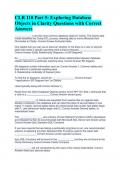Overig
Pharmacology, RNSG 1301, Chapter 1 Objectives- Questions and Answers
Document includes the questions and answers for Chapter 1 Objectives in Abrams' Clinical Drug Therapy (ISBN-13: 9781975136130) textbook, and answers include page numbers. This textbook is used in Pharmacology RNSG 1301 at El Paso Community College.
[Meer zien]












